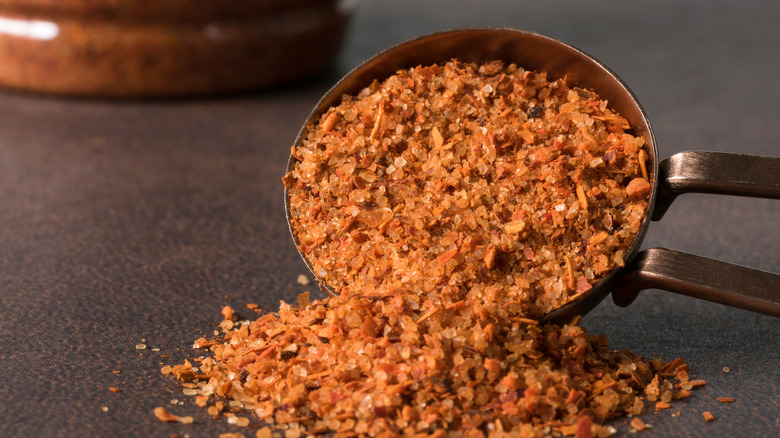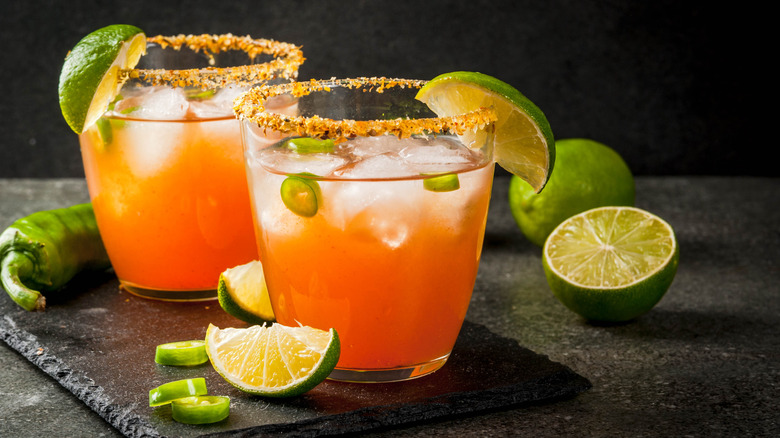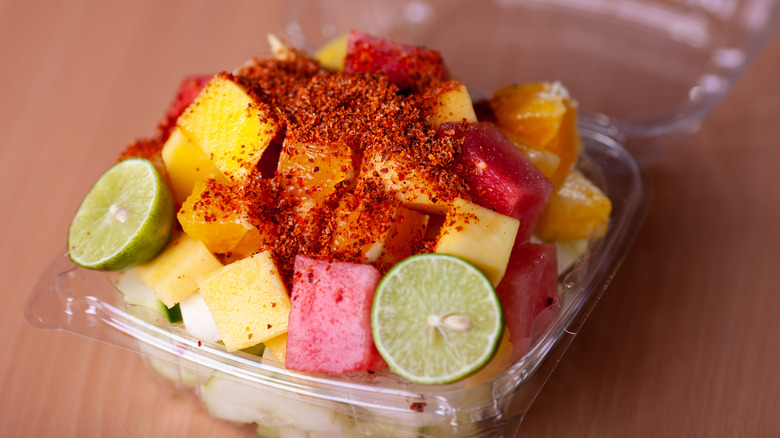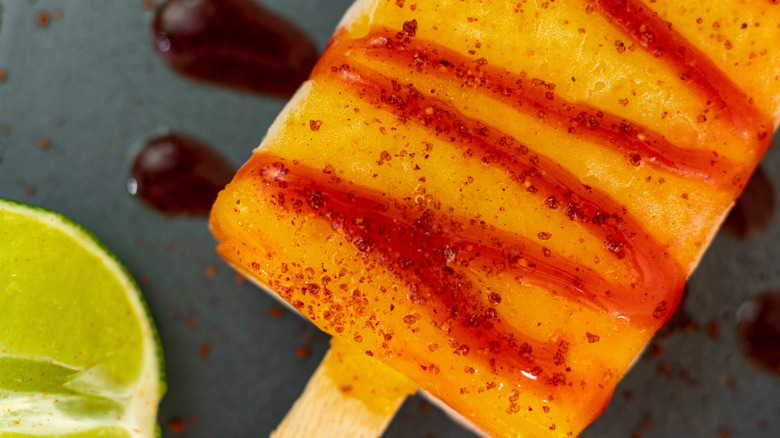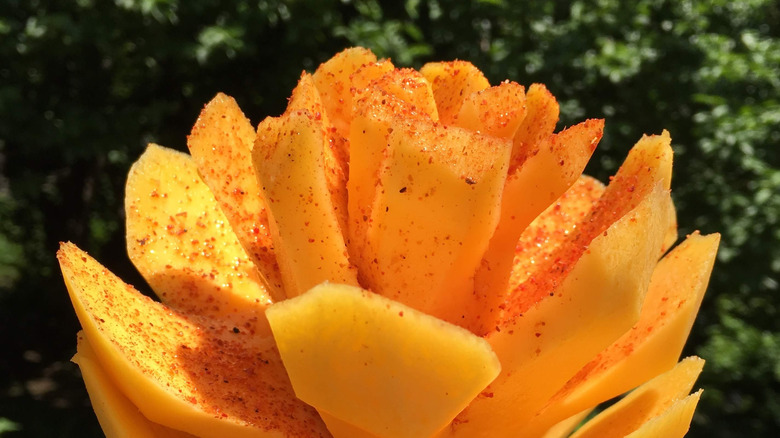What Is Tajín Seasoning And What Does It Taste Like?
There's no denying the affinity between chiles and lime, and their commingling delights the palate in the most wonderful way. Those lime wedges served with your street tacos aren't just for decoration; a squeeze of tangy citrus partners perfectly with chile-rich Mexican dishes. The combination of lime juice, chile powder, and salt is practically magical; the blend intensifies the flavor of a variety of foods, especially fresh fruits and vegetables.
That brings us to Tajín, a blend of dried granulated chiles (a combination of chiles de árbol, guajillo, and pasilla), dehydrated lime, and salt (via The New York Times). Tajín was invented in 1985 by Horacio Fernandez, who aspired to preserve the flavors of his grandmother's delicious chile sauce by creating a similar-yet-portable spice blend and condiment, Thrillist notes. Fernandez coined the spice's name after El Tajín, an archaeological site in southern Mexico, because the word "aji" translates to chile in Nahuatl, the Uto-Aztecan language.
What are the ingredients in Tajín?
Tajín Clásico is a simple combination of dried, ground red chiles, sea salt, and dehydrated lime juice, plus a wee bit of anti-caking agent to keep the mixture from clumping. The salty/tangy condiment has an easy-to-understand (and pronounce) ingredient list and contains zero artificial flavors, artificial colors, or sugar. The Tajín website notes there is also a low-sodium version of the classic blend, and a Tajín habanero seasoning, which contains habanero chiles, lime juice, and salt. If you're looking for something a little saucier, Tajín offers a Tajín Clásico Regular Snack sauce with a "spicy kick," and a sweet Chamoy Mild Sauce, boasting hints of apricot. Both sauces have water as the first ingredient, meaning they're basically liquid versions of the flavorful dried spice blend.
Nutritionally, one serving (1/4 teaspoon) of Tajín contains zero calories, carbs, protein, or fat, and 190 milligrams of sodium (or 8% of your daily recommendation for salt). The low-sodium version contains 120 milligrams of sodium (or 5% of your daily recommended maximum).
What does Tajín taste like?
Tajín's flavor is perky and citrusy with distinct notes of salt, and subtle nuances of dried chiles. The combination of tangy, salty, and smoky makes Tajín ideal for both sweet and savory foods, including sliced fruit and vegetables, creamy corn dishes, marinades, meat, fish, and seafood.
Pepperscale adds that Tajín is super mild, stating that "If you can handle a poblano pepper, you can handle Tajín." The site explains that the real star of the tastebud show is the salty lime — and that's the flavor blast you get from the minute the seasoning hits your tongue. Then, as the zingy lime mellows, the dried chiles start to simmer on your palate, leaving you with a pleasant, low-heat sensation. Like "Cinco de Mayo in powder form." Chili Pepper Madness agrees and adds that Tajín is similar to those tortilla chips with a hint of lime, the spice delivers the "right combination of salty, tangy, and spicy to satisfy your taste buds."
How to use Tajín
Boasting the perfect balance of tangy, salty heat, there are endless uses for Tajín. A little goes a long way, and a sprinkle of Tajín can add big flavor to mango, watermelon, pineapple, and fresh fruit salads. The ultra-colorful dusting of seasoning makes a great presentation, but you can also fold the spice into your fresh fruit to cover every inch with flavor. Use Tajín on snacks like fresh, roasted, and grilled vegetables (like Mexican street corn); roasted cashews, pumpkin seeds, chickpeas, and sunflower seeds; popcorn and potato chips. Additionally, the blend can be used as a dry rub for beef, poultry, pork, and seafood, and as a substitute for the traditional salt rim on margaritas, micheladas, lemonade, limeade, and mango-based drinks.
Some other creative ways to incorporate Tajín's chile-lime kick into your dishes include in tuna salad, popsicles, and angel food cake. You can add Tajín to apple chips and sweet potato fries. The spice blend also elevates dishes as disparate as grilled shrimp and salmon, roasted oysters, hard-boiled eggs, breakfast burritos, marinades, hummus, salad dressing, dips, and sauces.
Where to buy Tajín
Tajín is sold in the spice aisle and/or international foods section of most major U.S. grocery retailers. You can also find Tajín in big box stores nationwide, per the brand's website. Take note: sometimes the seasoning blend is actually in the produce section, which makes sense when you consider its affinity with fresh fruits and vegetables. If your store doesn't have it, Amazon or any Mexican specialty store most certainly will. If you want to craft a similar chile-salt-lime blend with your own pantry staples, Isabel Eats recommends combining equal parts red chile powder, crystallized lime powder, and fine sea salt.
Chili Pepper Madness also shares its homespun version of Tajín, which consists of paprika or red chili powder, dried lime zest, ground cumin, garlic powder, onion powder, grounded coriander, salt, and cayenne pepper powder, and sugar.
